Kaposi sarcoma-associated herpes virus (KSHV) G protein-coupled receptor (vGPCR) activates the ORF50 lytic switch promoter: a potential positive feedback loop for sustained ORF50 gene expression
- PMID: 19640558
- PMCID: PMC2747482
- DOI: 10.1016/j.virol.2009.07.002
Kaposi sarcoma-associated herpes virus (KSHV) G protein-coupled receptor (vGPCR) activates the ORF50 lytic switch promoter: a potential positive feedback loop for sustained ORF50 gene expression
Abstract
KSHV vGPCR, a lytic cycle associated protein, induces several signaling pathways leading to the activation of various transcription factors and consequently the expression of cellular and viral genes. Though the role of vGPCR in KSHV tumorigenicity has been well studied, its function related to the viral life cycle is poorly understood. Reduction in vGPCR by RNA interference also resulted in the reduction in KSHV lytic switch ORF50 gene and protein expression. Induction of vGPCR by doxycycline in BC3.14 cells also resulted in more KSHV production. When this was explored, induction of the ORF50 promoter by vGPCR expression was observed. Further examination of the molecular mechanisms by which vGPCR regulates the ORF50 promoter, using various ORF50 promoter constructs, revealed that induction of ORF50 promoter by vGPCR did not involve AP1 but was dependent on Sp1 and Sp3 transcription factors. vGPCR signaling led to an increase in Sp1 and Sp3 DNA binding activity and a decrease in histone deacetylase (HDAC) activity. These activities were pertussis toxin independent, did not involve Rho and Rac-GTPases and involved the heterotrimeric G protein subunits Galpha12 and Galphaq. Studies using pharmacologic inhibitors and dominant-negative proteins identified phospholipase C, the novel protein kinase C (novel PKC) family and protein kinase D (PKD) as part of the signaling initiated by vGPCR leading to ORF50 promoter activation. Taken together, this study suggests a role for vGPCR in the sustained expression of ORF50 which could lead to a continued activation of lytic cycle genes and ultimately to successful viral progeny formation.
Figures
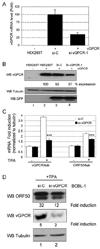
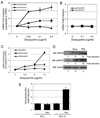
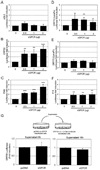
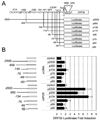
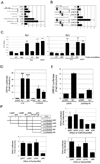
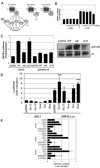
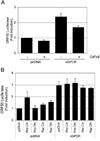

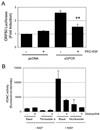

Similar articles
-
CCAAT/enhancer-binding protein-alpha is induced during the early stages of Kaposi's sarcoma-associated herpesvirus (KSHV) lytic cycle reactivation and together with the KSHV replication and transcription activator (RTA) cooperatively stimulates the viral RTA, MTA, and PAN promoters.J Virol. 2003 Sep;77(17):9590-612. doi: 10.1128/jvi.77.17.9590-9612.2003. J Virol. 2003. PMID: 12915572 Free PMC article.
-
Sp3 Transcription Factor Cooperates with the Kaposi's Sarcoma-Associated Herpesvirus ORF50 Protein To Synergistically Activate Specific Viral and Cellular Gene Promoters.J Virol. 2020 Aug 31;94(18):e01143-20. doi: 10.1128/JVI.01143-20. Print 2020 Aug 31. J Virol. 2020. PMID: 32641483 Free PMC article.
-
An Sp1 response element in the Kaposi's sarcoma-associated herpesvirus open reading frame 50 promoter mediates lytic cycle induction by butyrate.J Virol. 2005 Feb;79(3):1397-408. doi: 10.1128/JVI.79.3.1397-1408.2005. J Virol. 2005. PMID: 15650166 Free PMC article.
-
The Rta/Orf50 transactivator proteins of the gamma-herpesviridae.Curr Top Microbiol Immunol. 2007;312:71-100. doi: 10.1007/978-3-540-34344-8_3. Curr Top Microbiol Immunol. 2007. PMID: 17089794 Review.
-
Lytic cycle switches of oncogenic human gammaherpesviruses.Adv Cancer Res. 2007;97:81-109. doi: 10.1016/S0065-230X(06)97004-3. Adv Cancer Res. 2007. PMID: 17419942 Review.
Cited by
-
Recombinant Murine Gamma Herpesvirus 68 Carrying KSHV G Protein-Coupled Receptor Induces Angiogenic Lesions in Mice.PLoS Pathog. 2015 Jun 24;11(6):e1005001. doi: 10.1371/journal.ppat.1005001. eCollection 2015 Jun. PLoS Pathog. 2015. PMID: 26107716 Free PMC article.
-
Metabolic reprogramming of Kaposi's sarcoma associated herpes virus infected B-cells in hypoxia.PLoS Pathog. 2018 May 10;14(5):e1007062. doi: 10.1371/journal.ppat.1007062. eCollection 2018 May. PLoS Pathog. 2018. PMID: 29746587 Free PMC article.
-
Egr-1 regulates RTA transcription through a cooperative involvement of transcriptional regulators.Oncotarget. 2017 Sep 5;8(53):91425-91444. doi: 10.18632/oncotarget.20648. eCollection 2017 Oct 31. Oncotarget. 2017. PMID: 29207655 Free PMC article.
-
Human herpesvirus 8 induces polyfunctional B lymphocytes that drive Kaposi's sarcoma.mBio. 2014 Sep 2;5(5):e01277-14. doi: 10.1128/mBio.01277-14. mBio. 2014. PMID: 25182322 Free PMC article.
-
Inhibiting Protein Kinase D Promotes Airway Epithelial Barrier Integrity in Mouse Models of Influenza A Virus Infection.Front Immunol. 2020 Dec 14;11:580401. doi: 10.3389/fimmu.2020.580401. eCollection 2020. Front Immunol. 2020. PMID: 33381112 Free PMC article.
References
-
- Alberts BLJ, Raff M, Roberts K, Walter P. Molecular biology of the cell. 2002
-
- Bais C, Van Geelen A, Eroles P, Mutlu A, Chiozzini C, Dias S, Silverstein RL, Rafii S, Mesri EA. Kaposi's sarcoma associated herpesvirus G protein-coupled receptor immortalizes human endothelial cells by activation of the VEGF receptor-2/ KDR. Cancer Cell. 2003;3(2):131–143. - PubMed
Publication types
MeSH terms
Substances
Grants and funding
LinkOut - more resources
Full Text Sources
Research Materials
Miscellaneous

